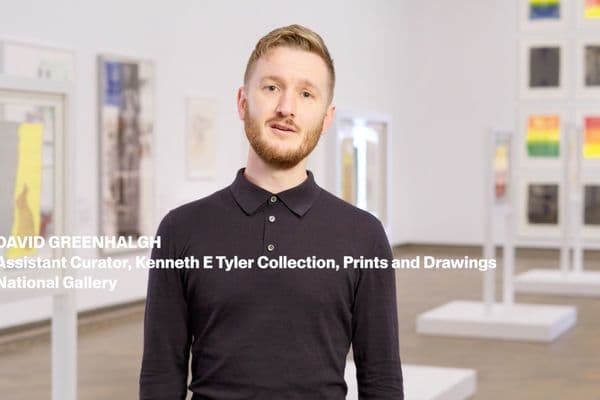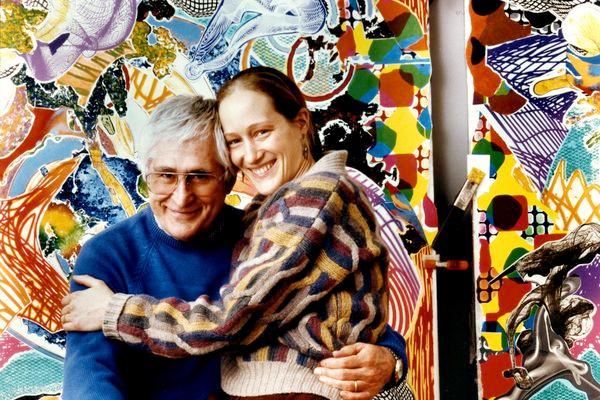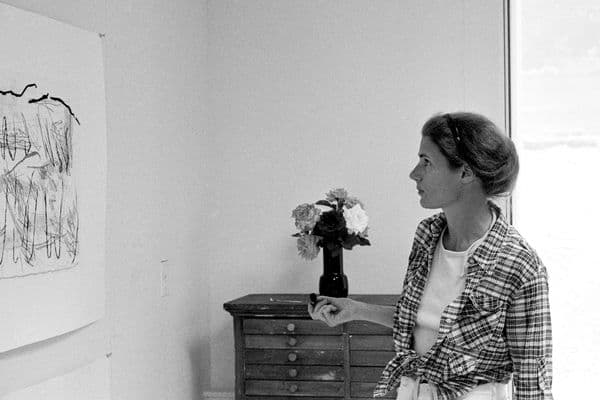Rauschenberg & Johns
Significant Others
16 Nov 2024 – 9 Feb 2025
Geelong Gallery, Geelong VIC

Jasper Johns, Gemini G.E.L., Bent "Blue"; from Fragments - according to what, 1971, National Gallery of Australia, Kamberri/Canberra, Purchased 1973. © Jasper Johns. VAGA/Copyright Agency.
‘Jasper and I used to start each day by having to move out from Abstract expressionism. We were the only people who were not intoxicated with [them].’
About
In the early 1950s, at the height of the Abstract Expressionist movement, a new avant-garde began to emerge from a relationship between two young artists. From their run-down New York studios, Robert Rauschenberg and Jasper Johns began a private creative dialogue that introduced everyday signs, objects, and media into their work, collapsing the distinction between art and life. While their relationship would end after seven years, their art would continue to radiate the new ideas of their creative exchange.
This exhibition will draw upon the National Gallery’s Kenneth Tyler Collection of prints with works by both artists produced between 1967 and 1973, and holdings of key works by their predecessors and contemporaries.
Curator: David Greenhalgh, Kenneth E Tyler Assistant Curator, Prints and Drawings.

Jasper Johns, Gemini G.E.L. Color numeral series, 1968, National Gallery of Australia, Kamberri/Canberra, © Jasper Johns/Copyright Agency, 2022, © Gemini Ltd/Kenneth E. Tyler

Robert Rauschenberg, Gemini G.E.L., Cardbird door; from Cardbird, 1971, National Gallery of Australia, Kamberri/Canberra, purchased 1975 © Robert Rauschenberg. VAGA/Copyright Agency

(from left) Robert Rauschenberg, Gemini G.E.L. Publicon - Station IV , 1978 and Publicon - Station I 1978, National Gallery of Australia, Kamberri/Canberra © Robert Rauschenberg/Copyright Agency, 2022, © Gemini Ltd/Kenneth E. Tyler

Installation view, Rauschenberg & Johns: significant others, National Gallery of Australia, Kamberri/Canberra, 2022
Dates & Venues
National Gallery of Australia, ACT
11 Jun 2022 – 29 Jan 2023
Touring dates
2023/2024
- Araluen Arts Centre, NT
11 Mar – 14 May 2023 - Ipswich Art Gallery, QLD
3 Jun – 30 Jul 2023 - Cairns Art Gallery, QLD
9 Sep – 19 Nov 2023 - Museum of Art and Culture yapang Lake Macquarie, NSW
9 Dec 2023 – 4 Feb 2024 - Western Plains Cultural Centre Dubbo, NSW
1 Jun 2024 – 15 Sep 2024 - Geelong Gallery, VIC
16 Nov 2024 – 9 Feb 2025
Works of Art

Robert Rauschenberg, Gemini G.E.L., Kenneth Tyler, Booster; from Booster and 7 studies, 1967, National Gallery of Australia, Kamberri/Canberra, Purchased 1973. © Robert Rauschenberg. VAGA/Copyright Agency.

Jasper Johns, Gemini G.E.L., Figure 1; from Color numeral series, 1969, National Gallery of Australia, Kamberri/Canberra, Purchased 1973. © Jasper Johns. VAGA/Copyright Agency.

Robert Rauschenberg, Gemini G.E.L., Test stone #5A; from Booster and 7 studies, 1967, National Gallery of Australia, Kamberri/Canberra, Purchased 1973. © Robert Rauschenberg. VAGA/Copyright Agency.

Jasper Johns, Gemini G.E.L., The critic smiles; from Lead relief series, 1969, National Gallery of Australia, Kamberri/Canberra, Purchased 1973. © Jasper Johns. VAGA/Copyright Agency.

Robert Rauschenberg, Gemini G.E.L., Publicon - Station IV, 1978, National Gallery of Australia, Kamberri/Canberra, Purchased 1979. © Robert Rauschenberg. VAGA/Copyright Agency.
Digital Publication

In 1953, on the corner of a New York City street, Robert Rauschenberg (1925–2008, United States) met Jasper Johns (b 1930, United States). These two young artists fell in love at a time when it was illegal to be in a same-sex relationship. It was also a time when New York’s artistic culture was dominated by Abstract Expressionism, an art movement of expressive gestures arising from the self or inner psyche. Not wanting to publicly expose their feelings and desires through art, Rauschenberg and Johns began a private creative dialogue, introducing everyday signs, objects and media into their work to create a distinctive, coded visual style. While their relationship would end in 1961, this formative exchange resonated throughout their lives and art. They became two of America’s most celebrated artists of the twentieth century.
In the late 1960s both Rauschenberg and Johns worked with celebrated printmaker Kenneth Tyler to create groundbreaking works in lithography and screenprint. Their experimental engagement with print processes made them important figures in the revival of printmaking in the United States. Expanding on ideas developed in their private creative dialogue, Rauschenberg and Johns helped reshape American printmaking.







///national-gallery-of-australia/media/dd/images/Jasper_Johns_162693.jpg)



